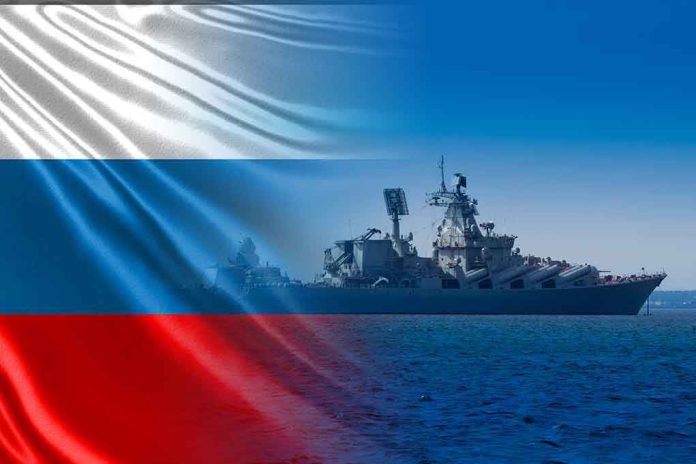
Russia’s grand Navy Day parade—once the pride of St. Petersburg—was canceled for the first time in recent memory, as the Kremlin scrambles to contain relentless Ukrainian drone attacks that shattered any illusion of control on Russian soil.
At a Glance
- Russia abruptly canceled its flagship Navy Day parade in St. Petersburg, citing security threats from Ukrainian drone strikes.
- Ukrainian forces reportedly launched over 100 drones, disrupting civilian life and exposing vulnerabilities in Russian defenses.
- The Kremlin’s move signals mounting anxiety about domestic security and erodes the image of Russian military might.
- Russian citizens, especially in St. Petersburg, faced flight delays, injuries, and the shock of a national tradition disrupted by war.
Kremlin Cancels Navy Day Parade Amid Drone Strike Chaos
On July 27, 2025, Russia’s Ministry of Defense announced the cancellation of its high-profile Navy Day parade in St. Petersburg and other naval strongholds. The reason? A security threat so severe, officials couldn’t even attempt the usual charade of “business as usual.” Ukrainian drones, once dismissed as a nuisance, hammered Russian airspace overnight—over 100 were reportedly intercepted, with more than 10 targeting the St. Petersburg region. The fallout was immediate: a woman wounded in Leningrad, St. Petersburg’s airport thrown into chaos, and the city’s annual show of naval power erased from the calendar.
Russia scales down celebrations honoring its navy as Ukraine launches more drone attacks https://t.co/FgHml0Sa5Q
— CTV News (@CTVNews) July 27, 2025
For ordinary Russians, the cancellation was a gut punch. Navy Day has long been a patriotic spectacle—warships on the Neva, sailors in dress whites, and President Vladimir Putin basking in the glow of Russian “strength.” This year, Putin didn’t even show up in person. He delivered a video address instead, praising sailors’ “bravery” and “heroism” as if a prerecorded pep talk could fill the crater left by Ukrainian drones and public embarrassment. Kremlin spokesman Dmitry Peskov didn’t mince words: “Security reasons are of utmost importance.” But when the state can’t guarantee safety at its own military parade, what message does that send to citizens—or the world?
Tradition Upended: St. Petersburg’s Parade and Putin’s Absence
The Navy Day parade, a Soviet-era tradition rebooted by Putin in 2017, has been a cornerstone of Russian national identity. In St. Petersburg, anticipation usually runs high as warships and submarines glide through the city’s waterways. This year, that anticipation curdled into confusion and disappointment. Local authorities initially posted, then deleted, an announcement about the cancellation, exposing layers of bureaucratic dysfunction. The Defense Ministry stepped in, making it official: no parade, no fanfare, no Putin. Instead, the city settled for a wreath-laying ceremony—hardly a substitute for the annual display of firepower and pride.
The cancellation sent ripples through the Russian body politic. For military families and veterans, it was a bitter pill. For everyday citizens already weary from war and economic hardship, it was another reminder that the Kremlin’s promises of stability and control are wearing thin. Even the vaunted “July Storm” naval exercises, carried on elsewhere, couldn’t distract from the fact that the home front is now a front line.
Ukrainian Drone Strikes Expose Security Weaknesses
Ukraine’s escalating use of drones has changed the nature of the conflict, dragging it ever deeper into Russian territory. The downing of 100 drones in a single night is a statistic that would have been unthinkable just a few years ago. Yet here we are: airports shut down, flights delayed, civilians injured, and the Russian military forced to hunker down on what’s supposed to be its proudest day. Security analysts point out that this marks a turning point. The Kremlin can no longer project unshakable strength with parades and pageantry while Ukrainian drones buzz past the world’s most expensive air defenses.
For the West, the episode is a stark illustration of modern asymmetric warfare. For Russia, it’s a humiliation—and a warning that the era of invulnerability is over. Political scientists argue that the move exposes the Kremlin’s vulnerability and erodes the psychological edge it once held over its own people. Even Russian state media, ever the cheerleaders, struggled to spin this as anything other than a loss. The official line is “prudent security,” but the reality is plain: the parade was canceled because the threat was real and unavoidable.
Broader Implications for Russian Society and the War
The immediate impact of the parade’s cancellation is felt most acutely in St. Petersburg, but the shockwaves extend far beyond. Economic disruptions from airport closures and event cancellations are only the beginning. The social cost—diminished morale, wounded pride, and growing anxiety—is harder to quantify but no less real. Some experts believe this could embolden Ukraine to target additional symbolic events, further undermining the Kremlin’s ability to maintain its carefully curated image of control.
Long-term, the Russian government may be forced to rethink how it secures public events, likely at the cost of further restricting public life and freedoms. For a population already wary of government overreach and the creeping militarization of daily existence, that’s cold comfort. Meanwhile, the Ukrainian military will likely see this as a strategic win—a demonstration that even Russia’s most sacred traditions are vulnerable.





